October 25 - 31, 2015: Issue 237
THE HANDICRAFTS OF CHIANG MAI
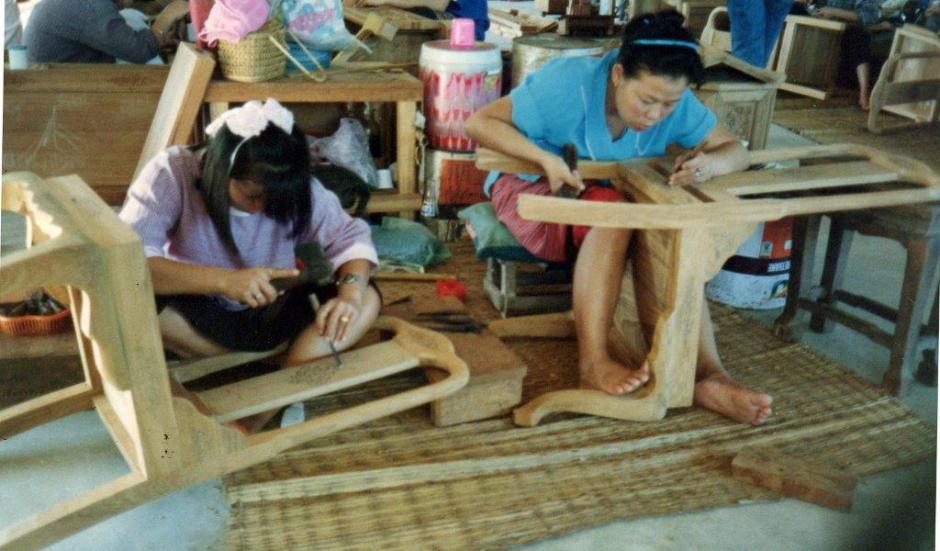
Carving designs into chairs
THE HANDICRAFTS OF CHIANG MAI
by George Repin
Chiang Mai, the second largest city of Thailand, is 710 Kms north of Bangkok in a valley 305 metres above sea level, making it a pleasant dry-season escape from the humidity of the capital.
Chiang Mai, often referred to as the Flower of the North offers historical temples, impressive mountain scenery, a wide array of handicrafts and is the gateway to areas inhabited by colourful minority populations sometimes referred to as “hill tribes”.
In 1298 King Mangrai founded, in Chiang Mai, the capital of his Thai Kingdom. However, in less than a century, relations with Ayuthaya became strained and for 400 years its southern borders were unsafe. Although Ayuthaya was crushed in the 16th Century Chiang Mai’s power began to wane and the Burmese invaded in the early 18th Century. They were defeated but the population had had enough and deserted the city. The city was re-established after 1796 when it came under the sway of Siam.
The city is famous for the wide variety of handicrafts which are produced in areas of the city specifically identified with individual crafts. The workshops welcome visitors and invite them to watch the items being produced. Needless to say most items are available, there and then, for purchase.
The umbrella-making area is east of the city. A cane stem is carefully cut and trimmed by a young man. Young girls cut bamboo strips which are then attached. Translucent paper, made locally from a special tree is meticulously pasted on and painted with two-toned brushes. The freshly dyed or painted umbrellas are left to dry in the sun.
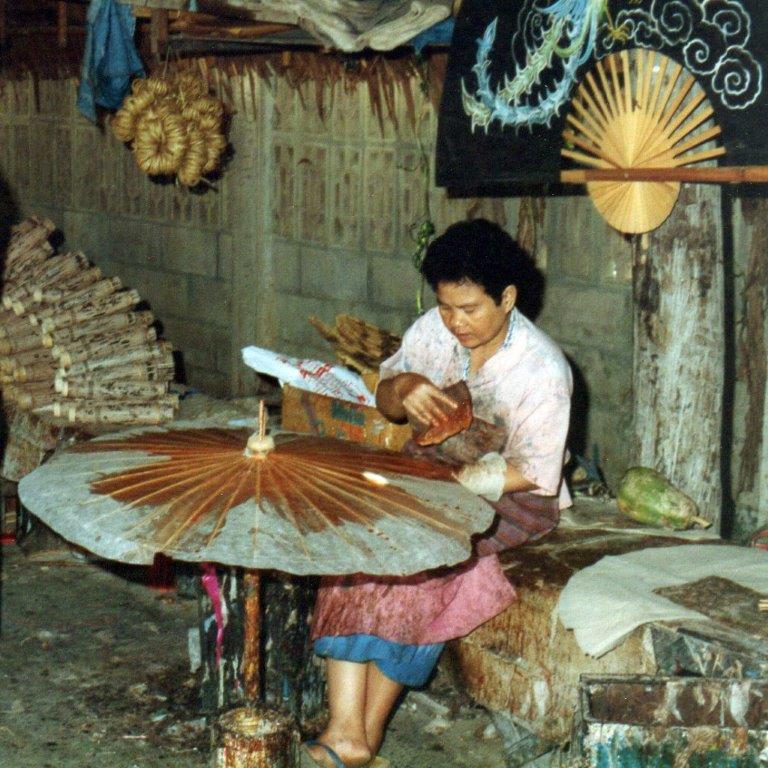
Making the frame of an umbrella
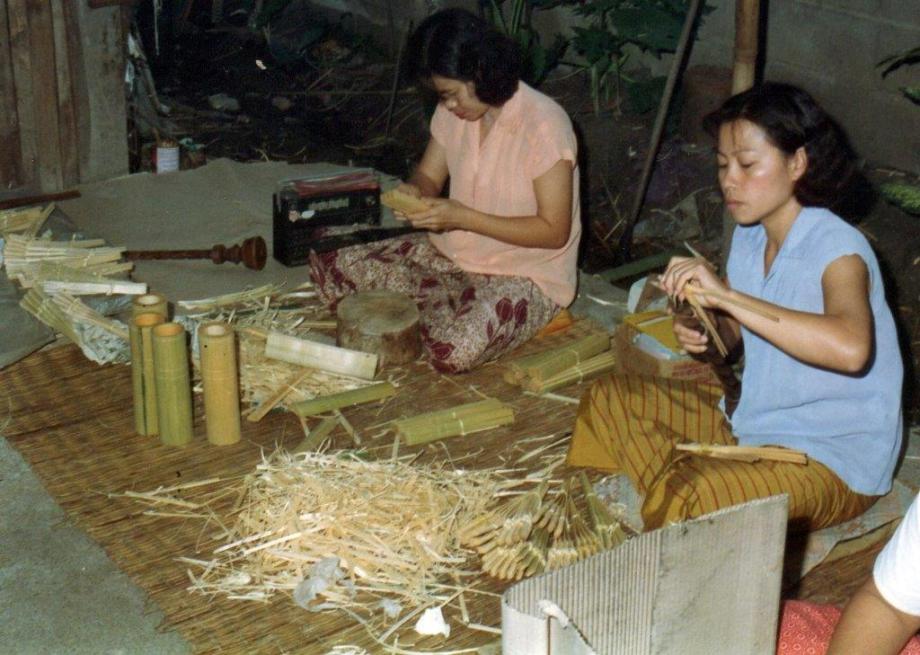
Girls cutting bamboo strips for umbrellas
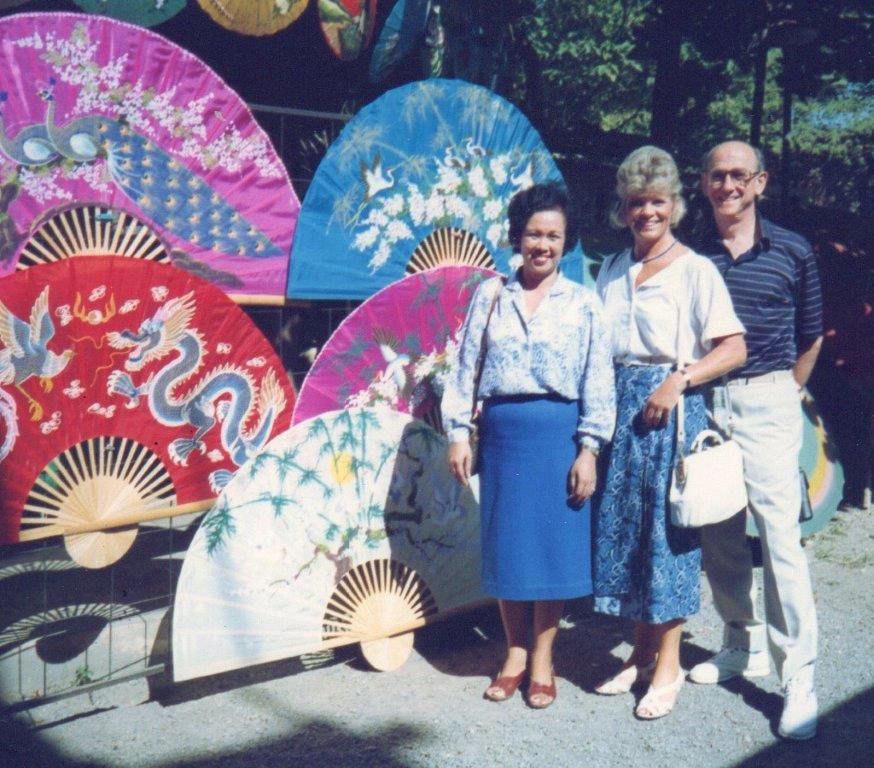
Painted umbrellas drying in the sun
In another area silk is extracted from silkworms. Breeding silkworms for the production of silk started in China at least 5000 years ago. Eggs take about 14 days to hatch and larvae emerge. After moulting four times they encase themselves in cocoons made of silk secreted by their salivary glands. The cocoons are then boiled to kill the silkworms. Each cocoon is made of a thread of raw silk from 300 to 900 metres in length. About 2000 to 3000 cocoons are needed to produce 1lb. (0.41 Kg.) of silk. The silk is spun into spools for weaving into the textile Thai silk.
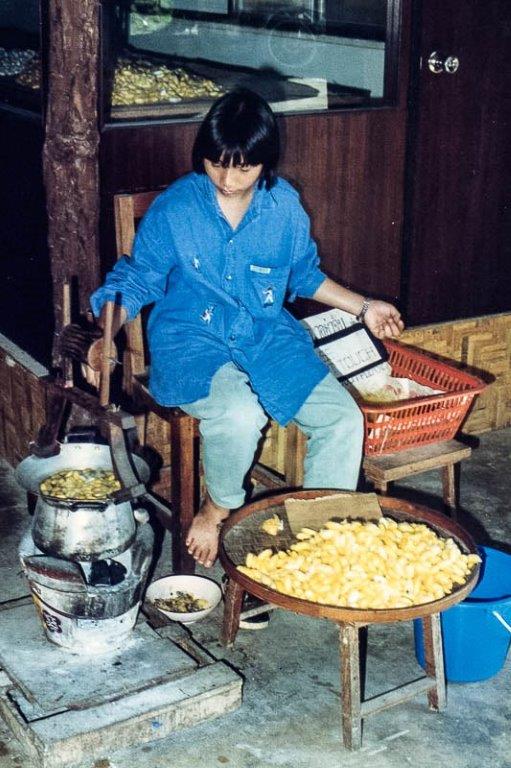
Boiling silkworm cocoons
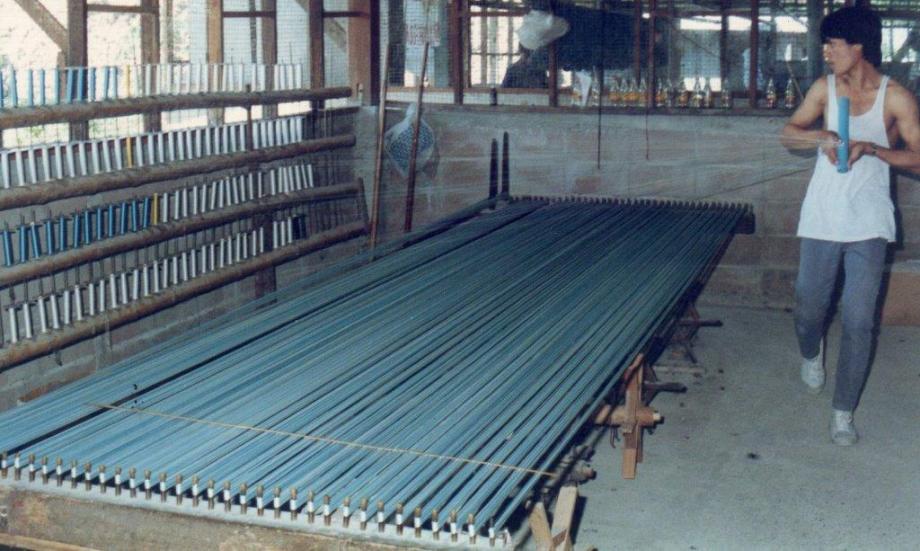
Spinning silk thread
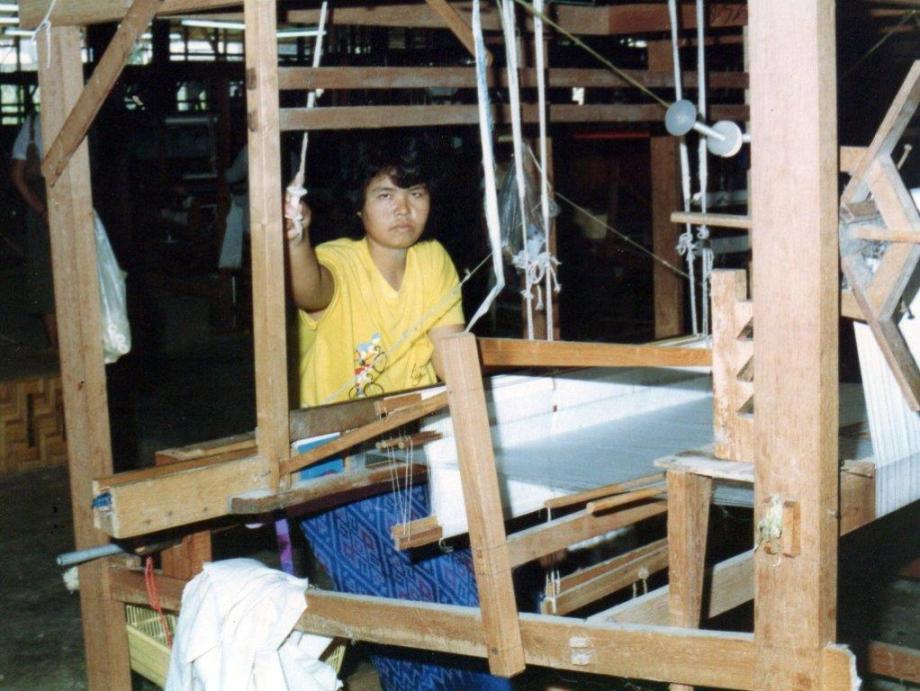
Weaving Thai Silk cloth
Near the south gate is the silversmith’s street where silver objects and jewellery are crafted.
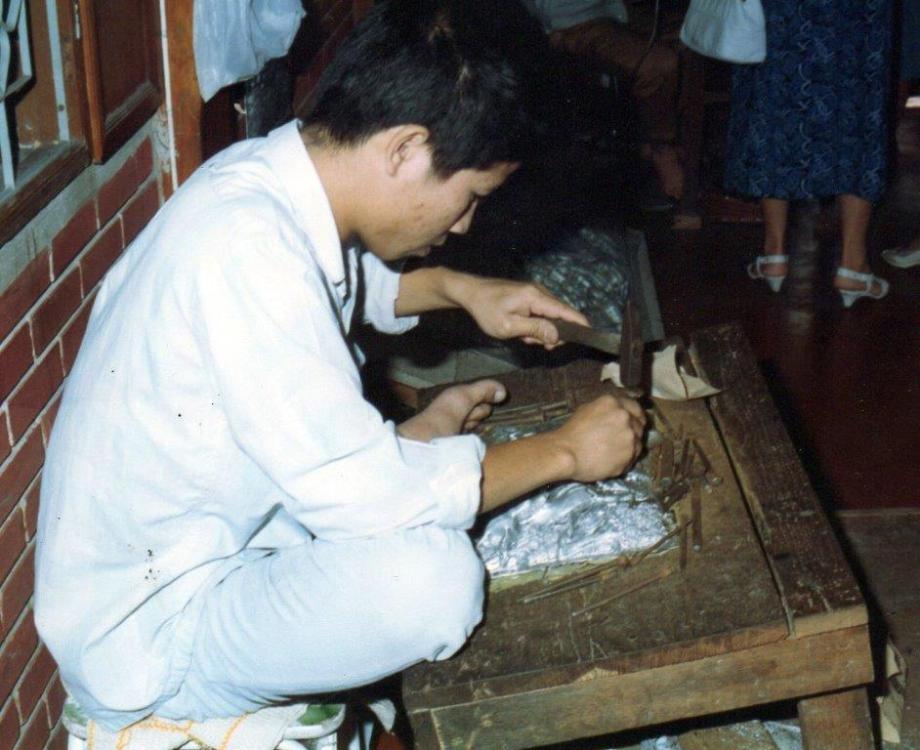
Silversmith at work
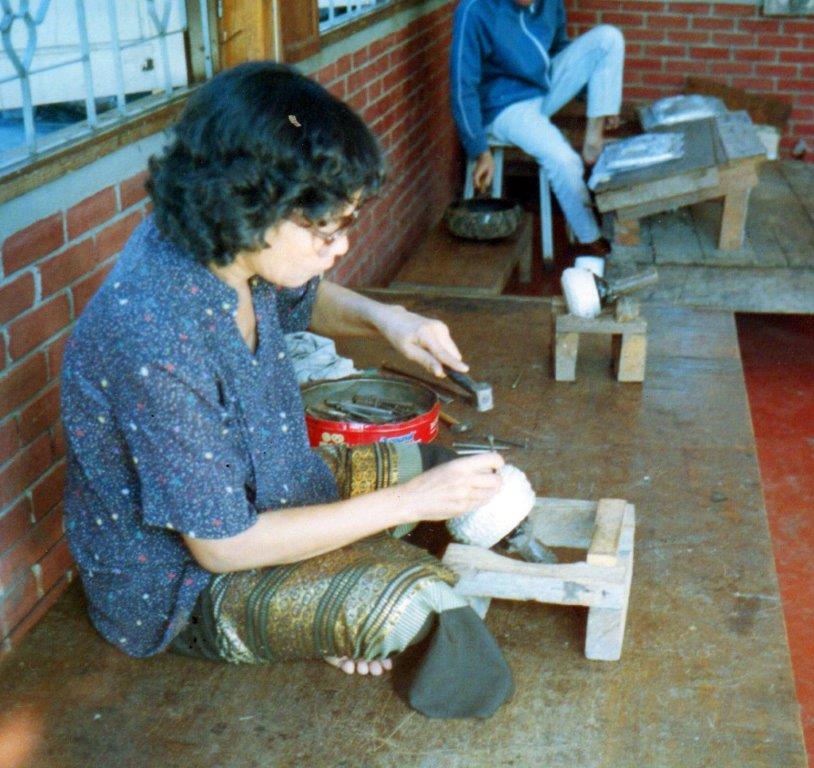
Woman imprinting the design into a silver bowl
Decorated teak furniture, decorative panels, salad bowls and trays are crafted on Rat Chiang Saen Street using well-seasoned teak. Items hawked in the street often are made of green teak which cracks within a few months.
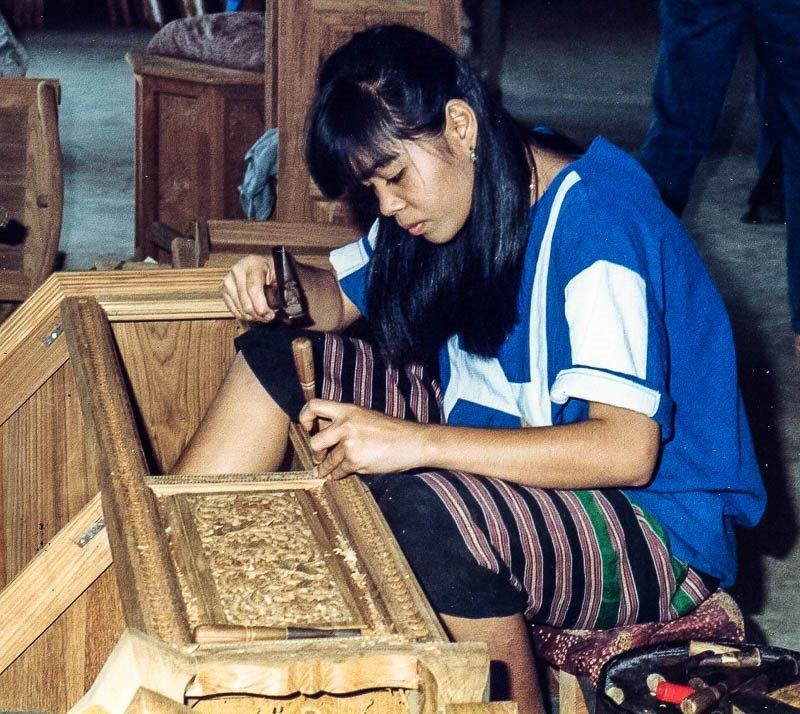
Girl carving a detailed design into an item of furniture
In other areas Thai Celadon and Thai Cotton is available.
A few hours around the various handicraft workshops in Chiang Mai is rewarding and time well spent.
Pictures taken by George Repin in 1987.
Previous Reflections by George Repin
The Nineteen Thirties Remembering Rowe Street The Sydney Push Saturday Night at the Movies Shooting Through Like A Bondi Tram A Stop On The Road To Canberra City Department Stores - Gone and Mostly Forgotten An Australian Icon - thanks to Billy Hughes Crossing The Pacific in the 1930s Hill End The Paragon at Katoomba Seafood In Sydney How Far From Sydney? Cockatoo Island Over The Years The Seagull at the Melbourne Festival in 1991 Busby's Bore The Trocadero In Sydney Cahill's restaurants Medical Pioneers in Australian Wine Making Pedal Power and the Royal Flying Doctor Service Pambula and the Charles Darwin Connection Gloucester and the Barrington Tops A Millenium Apart Have You Stopped to Look? Gulgong Il Porcellino Olympia Durham Hall Sargent's Tea Rooms Pie Shops and Street Photographers The Ballet Russes and Their Friends in Australia Hotels at Bondi Alma Ata Conference - 1978 Keukenhof - 1954 The Lands Department Building and Yellowblock Sandstone The Goroka Show - 1958 A Gem On The Quay Staffa The Matson Line and Keepsake Menus Kokeshi Dolls The Coal Mine At Balmain The Hyde Park Barracks The Changing Faces Of Sydney From Pounds and Pence to Dollars and Cents Nell Tritton and Alexander Kerensky Making A Difference In Ethiopia William Balmain J C Bendrodt and Princes Restaurant Azzalin Orlando Romano and Romano's Restaurant Waldheim Alcohol in Restaurants Before 1955 King Island Kelp The Mercury Theatre Around Angkor - 1963 Angkor Wat 1963 Costumes From the Ballets Russe Clifton at Kirribilli Chairman Mao's Personal Physician The Toby Tavern The MoKa at Kings Cross The Oceaographic Museum in Monaco The Island of Elba Russian Fairy Tale Plates Meteora Souda Bay War Cemetery Barrow, Alaska Cloisonné Tripitaka Koreana Minshuku The Third Man Photographs and Memories Not A Chagall! Did You Listen? Did You Ask? Napier (Ahuriri, Maori) New Zealand Borobudur Ggantija Temples Plumes and Pearlshells Murano University of Padua Ancient Puebloe Peoples - The Anasazi Pula The Gondolas of Venice Cinque Terre Visiting the Iban David The Living Desert Bryce Canyon National Park Aphrodisias The Divine Comedy Caodaism Sapa and local Hill People A Few Children Cappadocia Symi Jean-Marie Tjibaou Cultural Centre Aboriginal Rock Art on Bigge Island ANZAC Cove (Ari Burnu) 25 April, 1997 Hotere Garden Oputae Children of the Trobriand Islands Page Park Market - Rabaul Rabual Kotor, Montenegro Galleries of Photographs I Lascaux Galleries of Photographs II The Cathedral of St. James – Šibenik, Croatia Ivan Meštrović - Sculptor Delphi Gallery of Photographs III
Copyright George Repin 2015. All Rights Reserved.